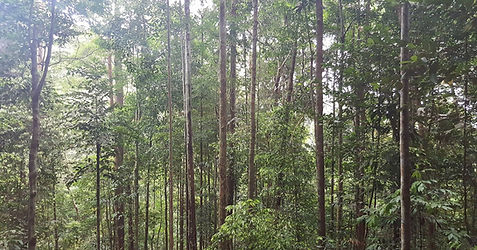Primate Watching
Primatology
Taxonomy & Occurrence
Dusky Langurs can be found in Myanmar, Peninsular Malaysia, and Thailand. Seven subspecies are currently recognised: T. o. carbo, T. o. flavicauda, T. o. halonifer, T. o. obscurus, T. o. sanctorum, T. o. seimundi, and T. o. styx [1].
IUCN Conservation Status
Vulnerable
Seeing this Species
In general, leaf monkeys (Presbytis, Semnopithecus, Trachypithecus) are shy and rather skittish. They are also primarily arboreal (tree-dwelling), so if they decide to stay away from you, it only takes a couple of leaps into the forest and you would lose them. The Reid's Dusky Langur can be considered 'easier' to see compared to the other species of leaf monkeys as they seem less afraid of humans. They are also more numerous relative to threatened species.
Gunung Lambak, Kluang district, Johor state, Malaysia
Gunung Lambak (which means Flea Mountain in Malay) is a twin-peak mountain which stands at 510m a.s.l. at its highest. A visitor permit is not required to visit this Gunung (Mountain in Malay). It is a popular trekking destination among locals, and despite regular human traffic on the trails, the Reid's Dusky Langur can be regularly observed. It is also a place where all six species of non-human primates in Johor state can be found!
Gunung Lambak is located in Kluang district in the state of Johor. It is about 3.5 hours drive south of Kuala Lumpur, or 2.5 hours drive north of Singapore. Regular buses are also available from major bus terminals in Malaysia and Golden Mile bus complex in Singapore. Tour buses from Singapore would take 4 hours and cost S$20 one-way per person (in 2017).
Probability of success: ◆ ◆ ◆ ◆ ◇
Overlapping species:
-
Malaysian Lar Gibbon (Hylobates lar lar)
-
Long-tailed Macaque (Macaca fascicularis fascicularis)
-
Southern Pig-tailed Macaque (Macaca nemestrina)
© Andie Ang
Gunung Lambak, Malaysia
Other sites:
Panti Bird Sanctuary, Kota Tinggi district, Johor state, Malaysia
From Singapore, cross the Woodlands border checkpoint to get into Johor, Malaysia, and once there, take a cab towards Kota Tinggi. When at Kota Tinggi on highway Jalan Jemaluang, continue past the Gunung Panti Recreational Forest (this is not it), and look out for road marker # on the left. Right after marker #270, you will see old WWII bunkers, and a sign that points you into Panti Bird Sanctuary (Suaka Burung Panti) on the left. It takes about 90 minutes on cab and costs $55 (SG$70) one way. There is a new administration office with haphazard system of issuing permits and collecting a small fee, but it is closed most of the time (even in that case, there is no problem walking in). Walk on the main trail (it starts with paved road and continues on dirt road, which is relatively easy to walk on).
Getting away from Panti is not as easy as getting there, so you might want to arrange with the cab driver to pick you up once you are done. Hailing a cab by the road may not be easy. Alternatively, wait by the roadside next to the bunker for a bus that takes you into the Kota Tinggi bus terminal. Buses come every hour (but not with a fixed schedule), and cost $2 (RM$6). There, a cab to Singapore costs $45. If you plan on spending more days for Panti, Rest Inn Hotel in Kota Tinggi is relatively cheap and good, where you can also call a cab to send you to Panti before dawn ($8).
Panti Bird Sanctuary is also very popular with Singaporean and Malaysian birders.
Overlapping species:
-
Malaysian Lar Gibbon (Hylobates lar lar)
-
Long-tailed Macaque (Macaca fascicularis fascicularis)
-
Southern Pig-tailed Macaque (Macaca nemestrina)
Gunung Pulai, Kulai district, Johor state, Malaysia
Overlapping species:
-
Malaysian Lar Gibbon (Hylobates lar lar)
-
Long-tailed Macaque (Macaca fascicularis fascicularis)
-
Southern Pig-tailed Macaque (Macaca nemestrina)
Local contacts: Andie Ang (andie.ang@primatewatching.com)

The numbers indicate distance, not elevation. Peak stands at 510m a.s.l.
© Andie Ang
Gunung Lambak

© Sabrina Jabbar
Gunung Lambak
References
[1] Boonratana R., Ang A. & Traeholt C., 2021. Trachypithecus obscurus ssp. obscurus. The IUCN Red List of Threatened Species 2021: e.T39856A17988769. The IUCN Red List of Threatened Species.
Page Last Updated: 3 July 2022
